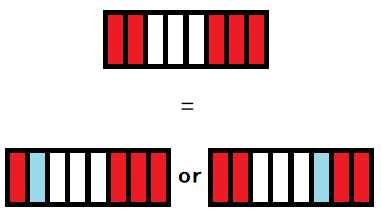标签:names 剪枝 main name blog cow 输入输出 hat yum
FJ has purchased N (1 <= N <= 2000) yummy treats for the cows who get money for giving vast amounts of milk. FJ sells one treat per day and wants to maximize the money he receives over a given period time.
The treats are interesting for many reasons:The treats are numbered 1..N and stored sequentially in single file in a long box that is open at both ends. On any day, FJ can retrieve one treat from either end of his stash of treats.Like fine wines and delicious cheeses, the treats improve with age and command greater prices.The treats are not uniform: some are better and have higher intrinsic value. Treat i has value v(i) (1 <= v(i) <= 1000).Cows pay more for treats that have aged longer: a cow will pay v(i)*a for a treat of age a.Given the values v(i) of each of the treats lined up in order of the index i in their box, what is the greatest value FJ can receive for them if he orders their sale optimally?
The first treat is sold on day 1 and has age a=1. Each subsequent day increases the age by 1.
约翰经常给产奶量高的奶牛发特殊津贴,于是很快奶牛们拥有了大笔不知该怎么花的钱.为此,约翰购置了N(1≤N≤2000)份美味的零食来卖给奶牛们.每天约翰售出一份零食.当然约翰希望这些零食全部售出后能得到最大的收益.这些零食有以下这些有趣的特性:
?零食按照1..N编号,它们被排成一列放在一个很长的盒子里.盒子的两端都有开口,约翰每
天可以从盒子的任一端取出最外面的一个.
?与美酒与好吃的奶酪相似,这些零食储存得越久就越好吃.当然,这样约翰就可以把它们卖出更高的价钱.
?每份零食的初始价值不一定相同.约翰进货时,第i份零食的初始价值为Vi(1≤Vi≤1000).
?第i份零食如果在被买进后的第a天出售,则它的售价是vi×a.
Vi的是从盒子顶端往下的第i份零食的初始价值.约翰告诉了你所有零食的初始价值,并希望你能帮他计算一下,在这些零食全被卖出后,他最多能得到多少钱.
Line 1: A single integer, N
Lines 2..N+1: Line i+1 contains the value of treat v(i)
Line 1: The maximum revenue FJ can achieve by selling the treats
5 1 3 1 5 2
43
Explanation of the sample:
Five treats. On the first day FJ can sell either treat #1 (value 1) or treat #5 (value 2).
FJ sells the treats (values 1, 3, 1, 5, 2) in the following order of indices: 1, 5, 2, 3, 4, making 1x1 + 2x2 + 3x3 + 4x1 + 5x5 = 43.
思路:搜索、DP或贪心。
搜索没法用,因为这个题目数据范围不小,而且没法像求最小方案那样剪枝优化。
贪心很快能找到反例,例如(6, 1, 3, 4, 5),贪心做法是 5x1 + 4x2 + 3x3 + 1x4 + 6x5 = 56,然而存在着更优的解法:6x1 + 1x2 + 3x3 + 4x4 + 5x5 = 58。
因此只能用DP了。
思路我也不知道是怎么想出来的,也就是灵光一现吧。
设f[i][j]表示共拿了i个,右边拿了j个所得的最大收益;a[i]表示第i格零食的原始价值(即vi)。
那么有:
f[0][0]=0
f[i][0]=f[i-1][0]+a[i]*i
f[i][j]=max{a[i-1][j-1]+a[n-j+1]*i, a[i-1][j]+a[i-j]*i}
f[i][i]=f[i-1][i-1]+a[n-i+1]*i
第一个方程,如果取了0个东西,那收益就为0。
第二个方程,取了i个东西、右边取出0个,换句话说就是全部都从左边取。那么价值就是从左边取了(i-1)个东西+第i个东西的当前价值。
第三个方程分为两个部分,一个是a[i-1][j-1]+a[n-j+1]*i,另一个是a[i-1][j]+a[i-j]*i。
举个例子,比如“左边取了2个,右边取了3个”的状态,可以通过“左边取了1个,右边取了3个“+左数第2个东西的当前价值、或“左边取了2个,右边取了2个“+右数第3个东西的当前价值得到。
第一个是拿右边,第二个是拿左边。
这就是这个方程的由来。

第四个方程和第二个类似。
(区间DP?什么是区间DP?)
#include <cstdio> #include <algorithm> using namespace std; int a[2005]; int dp[2005][2005]; int main(){ int i, j; int n; int ans=0; scanf("%d", &n); for(i=1; i<=n; i++) scanf("%d", &a[i]); for(i=1; i<=n; i++){ dp[i][0]=dp[i-1][0]+a[i]*i; //明显只能拿左边 for(j=1; j<i; j++){ dp[i][j]=max(dp[i-1][j-1]+a[n-j+1]*i, dp[i-1][j]+a[i-j]*i); //前一个是拿右边,后一个是不拿右边 } dp[i][i]=dp[i-1][i-1]+a[n-i+1]*i; } for(i=0; i<=n; i++) ans=max(ans, dp[n][i]); printf("%d", ans); return 0; }
【洛谷P2858·动态规划】[USACO06FEB]奶牛零食Treats for the Cows
标签:names 剪枝 main name blog cow 输入输出 hat yum
原文地址:http://www.cnblogs.com/cutemaru/p/7520262.html